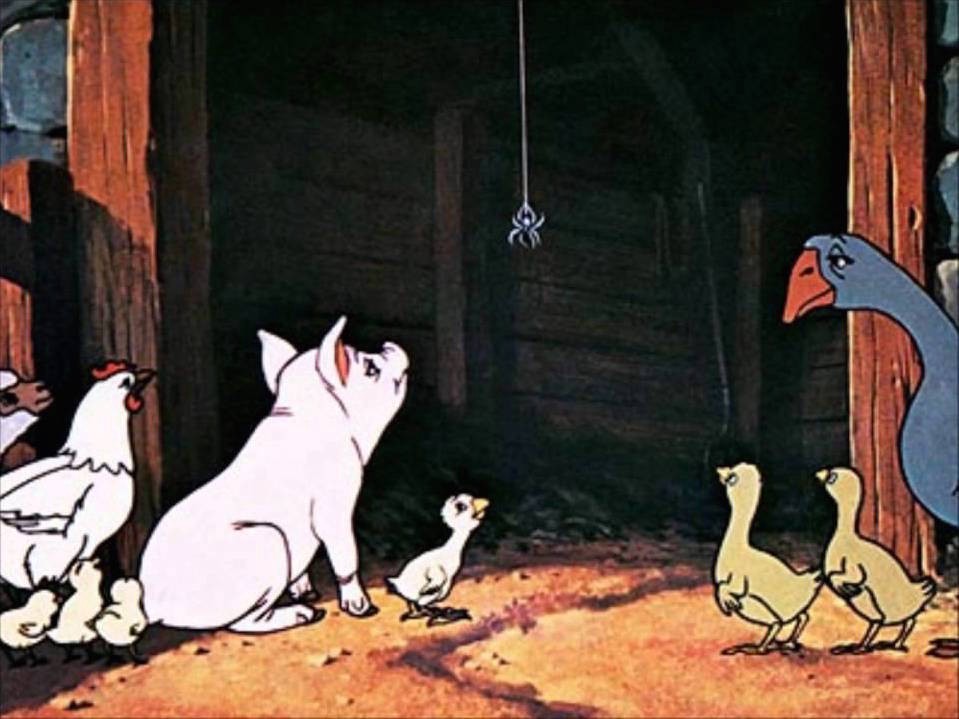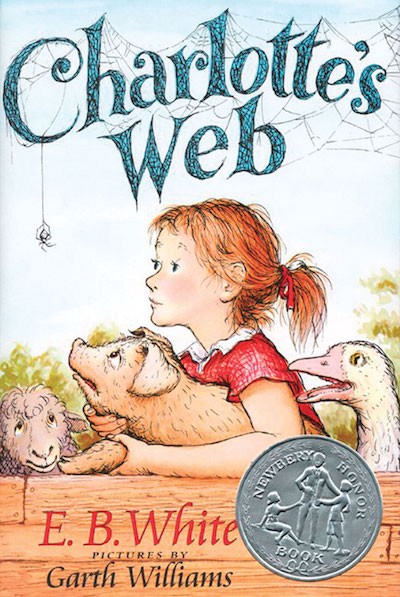What Children’s Literature Teaches Us About Money: E.B. White’s ‘Charlotte’s Web’
When $25—and a little magic—is enough to save one pig’s life.

There are a lot of things most of us can instantly recall about Charlotte’s Web: “some pig,” the way it taught us to spell “terrific,” Templeton singing “smorgasboard-orgasboard-orgasboard.” (That last one was from the 1973 animated movie, which I am sure most of us watched in elementary school.)
But I had forgotten how extraordinary this book really is. White’s language is both compact and rich with detail—on that first wet day, the kitchen “smelled of coffee, bacon, damp plaster, and wood smoke from the stove”—and he masterfully writes a story that is both for children and, in its own way, for adults.
More importantly, for this discussion: Charlotte’s Web is permeated—soaked through like Fern’s sneakers when she races out to save her pig—with both the tangible idea of money and the intangible idea of value.

In the first pages, we learn that Mr. Arable wants to kill the runt of that morning’s litter of pigs because you can’t make money off a small pig. (Also, if you know anything about pig farming, the runt is likely to slowly starve because it can’t compete with its larger siblings for food. Mr. Arable is being merciful.) His daughter Fern sees value in life, regardless of how much that value is worth in the marketplace—and the Arables see value in Fern, so they let the pig live.
Fern then gives the pig the most beautiful—i.e. valuable—name she knows: Wilbur.
When Wilbur gets too large to live in the house, Fern sells him to her uncle for $6—which is a transaction that has financial value for Mr. Zuckerman, as the story implies that this is a bargain price even for a runt, and emotional value for Fern, as she can visit Wilbur as often as she wants.
Next, we see Wilbur try to escape Mr. Zuckerman’s farm, and decide that getting to eat three delicious meals a day is worth living in captivity. (Hands up if you read Charlotte’s Web as a child and thought the description of pig slops were so appetizing that you wanted to try them yourself: “Warm milk, potato skins, wheat middlings, Kellogg’s Corn Flakes, and a popover left over from the Zuckermans’ breakfast.”) This scene is worth noting because it sets up the idea that everything is worth something; that is, there’s nearly always some transaction that will make it possible for you to do something you didn’t originally want to do.
And so it continues, in every chapter. Wilbur discovers that having a friend can add value to otherwise identical days. Charlotte explains that she must kill insects to “get her own living.” Templeton claims the goose’s “dud egg” because he is able to both articulate and defend its value.
Then we get to the novel’s turning point: Wilbur’s discovery that Mr. Zuckerman is planning to kill and sell him, and Charlotte’s decision to do everything she can to keep Wilbur alive. To pull this off, they have to make Mr. Zuckerman believe that Wilbur’s value—including his financial value—is greater alive than dead. But the reason Wilbur and Charlotte work together on this project, and in fact why the entire barnyard gets involved, is because Wilbur’s value in the social hierarchy is high enough that none of the other animals want to see him killed.
(It’s subtle, but worth noting: Mr. Zuckerman does not usually raise pigs. All of the other animals in his barnyard are used for their byproducts—eggs, wool—but not for their meat. None of the animals in this story are accustomed to the idea that one of them will be slaughtered for food.)
So we get “Some Pig, “Terrific,” and “Radiant.” When Wilbur is taken to the county fair and fails to win the blue ribbon because he is too small, Charlotte spins the word “Humble.” That’s when Mr. Zuckerman wins a $25 prize—not just for Wilbur, but also for “attracting so many visitors to our great County Fair.”
Charlotte increased Wilbur’s value, which increased the County Fair’s value, which sold more tickets, which earned Mr. Zuckerman $25, which saved Wilbur’s life.
Now we have to talk about Fern.
Fern misses Wilbur’s big moment—and remember, she used to visit Mr. Zuckerman’s farm every day just so she could see him—because she wants to ride the Ferris Wheel with Henry Fussy. (She even asks her mother for money so she can treat him, because he treated her the last time. A nice touch.)
Fern saved Wilbur’s life, made sure he went to a good farm, and visited him every day. Then she skipped out on his reward to go on a ride with some boy. The town doctor reassured Mrs. Arable that this would happen; that Fern would not spend her days sitting quietly in front of a pigpen, but would find a way to go add value to the community and, specifically, some young man’s life. The transition from childhood to adulthood, as it were.
Except Fern is EIGHT YEARS OLD.
I don’t know about you, but I wasn’t dreaming about becoming the future Mrs. Henry Fussy at eight. (Also, in a town where the local farmer is named “Arable,” stay away from the guy named “Fussy.”) It’s a weird note in an otherwise perfect story, and I’m kind of surprised that nobody said “ummm, maybe make her fifteen?”
But the overall point, even if it is bizarre coming from an eight-year-old, is that our values change over time. Even if it is heartbreaking to watch Fern ditch her closest friend for this boy she has literally met, like, once.
The epilogue, of course, is Wilbur getting to know Charlotte’s children—because Charlotte dies, spiders don’t live as long as pigs do, and Wilbur repays all of the value Charlotte gave him by making sure her egg sac survives and her children live.
So we learn that value can be passed down to the next generation; that what you do today can improve the lives of your children and grandchildren. Fern and Charlotte and even Templeton helped save Wilbur’s life, and now that he is certain he will not be turned into ham, he can devote his energy to helping others and share his wealth.
I have to be slightly cynical about this ending; sure, Mr. Zuckerman got his $25—the equivalent of $227 in 1952, when this book was published—but if hard times hit in a few years, what’s seriously to stop him from butchering his pig? White claims that Mr. Zuckerman still gets tourists to his farm, which is probably enough of an incentive, but I find that a little hard to believe—and this is in a novel where spiders can write.
But let’s say that it does in fact happen exactly as E.B. White says. Wilbur lives a long, happy life, and teaches Charlotte’s children and grandchildren how to be friends and how to share the value that he is sharing with them. If he had money, no doubt he would share it with the rest of the barnyard, the way he shares his food with Templeton. But since Wilbur doesn’t have money, he gives of himself, because he has been raised in a system that taught him that value is important and value can be distributed to others—and if you don’t have enough value, you may very likely get killed.
Previously:
What Children’s Literature Teaches Us About Money: Madeleine L’Engle’s ‘Meet the Austins’
Support The Billfold
The Billfold continues to exist thanks to support from our readers. Help us continue to do our work by making a monthly pledge on Patreon or a one-time-only contribution through PayPal.
Comments